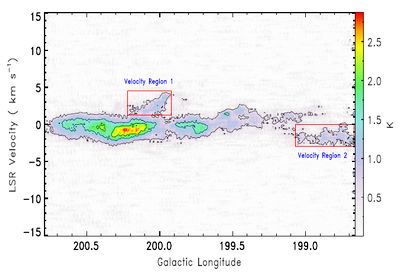The Astronomical Journal published a work about the dynamics and star formation of high-latitude gas — Gemini Molecular Cloud — in July 24, 2015, which conducted by research team of Xu Ye, Purple Mountain Observatory, Chinese Academy of Science. This work would be a good starting of a large-scale survey towards high-latitude molecular gas survey in the northern sky.
Although the study of high-latitude molecular gas was active in the 1980s and 1990s, relative to larger molecular gas surveys in Galactic plane, very few similar systemic studies were towards high galactic latitudes over the past several decades. Thus, relatively speaking, the observation toward the high latitude gas just like develops a piece of uncultivated land, especially for research in mm wavelength, which is a best choice to study the formation of molecular gas and star in the vicinity of our solar system. Moreover, the velocity structure of high-latitude gas is very simple and seldom has multi-peak structure, which is very contribute to study the dynamical structure of molecular cores for very little obstruct. In addition, because relative isolation among high-latitude gas, they are not so strongly interact with each other like gas in galactic plane, which shows a best advantage to study the formation of a single star.
Research worker of Purple Mountain Observatory asserted that the big difference among core candidates may be triggered by stochastic processes between clouds such as collisions and chaotic magnetic fields, rather than ordered motions such as rotation according to channel map of part of this cloud (Figure 1). And the analysis of line width indicates that the non-thermal broadening mechanism plays a dominant role in this cloud (Figure 2). As for star formation, the relationship between virial mass and LTE mass imply that: core candidates in this cloud are more likely unbound, and the power index value of 0.97 that we obtained is larger than both the value for gravitationally bound clumps and pressure-confined clumps, which may be a unique property of high-latitude gas. All of those results are contribute to light interest to high-latitude gas.

Figure 1. Longitude–velocity map in 12CO.
The first author of this work is LI Yingjie of Purple Mountain Observatory. This work is supported by the National Natural Science Foundation of China (grant Nos. 11133008 and 11233007), the Strategic Priority Research Program of the Chinese Academy of Sciences (grant No. XDB 09010300), and the Key Laboratory for Radio Astronomy. link of article: http://iopscience.iop.org/article/10.1088/0004-6256/150/2/60/pdf




